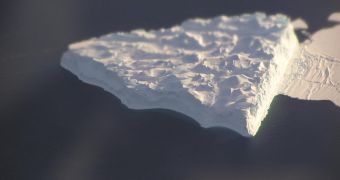11 % of the land surface is covered by ice (23 million square km).
14.1 million are in Antarctica, 21,000 square km in mountain glaciers in southern temperate zone, 100 square kilometers in tropical mountain glaciers, 100,111 square km in mountain glaciers in northern temperate zone and 2.2 million square km in the Arctic, (1.65 in Greenland alone).
97 % of the current ice surface and 99.75 % of its volume are located in Antarctica and Greenland. (90 % in Antarctica, with 29.46 million cubic km of ice: this is 66 % of the fresh water amount on Earth!).
Another 7 million square km of the ocean are covered by ice. 75 % of the world's fresh water reserves are located in ice. During the Ice Age they covered 38 % of the land surface.
The ice pack of Antarctica covers a surface greater than Europe's and is 5,000 m (16,670 ft) thick in some places (but 2,200 m or 7,300 ft on average), while the Greenland ice pack can be till 3,400 m (11,300 ft) thick. In the 80's, the thickness of the Antarctic ice shelf was already decreasing by 8.3 cm (3.3 inch) annually.
Greenland and Antarctica seem to be in fact archipelagos and only ice makes them appear as compact lands. From their central parts start ice flows which go down to the exterior.
When they reach the shore, they form floating ice shelves. In Antarctica they cover 1.5 million square km (as much as Alaska) and are on average 200-300 m (670-1,000 ft) thick.
When the air temperatures rise during the spring, the ice shelf starts to crack and free waters channels are formed. When the temperatures rise further, under the action of the waves and the winds, the shelf starts to fragment on the edges, forming huge ice floating blocks named icebergs, with start to drift to the lower latitudes with higher temperatures.
About 90 % of the iceberg is underwater, and only a very small part of it is visible as its tip.
In the northern Atlantic, the icebergs are carried on by the cold currents of Labrador and Greenland reaching south 50 degrees N.
Due to the low depth of the Arctic basin east of Greenland, especially on the Barents Sea, icebergs on the area cannot start drifting to the south.
Northern Pacific is free of icebergs, as they cannot pass off the Behring Strait.
Annually, 1,700 cubic km of Antarctica are chopped in icebergs. At 200 km (125 mi) off the Antarctica, there are 15-20 icebergs for each 100 square km. At about 60 degrees S, their density can be of 10 daily, but greatly reduced in size.
The icebergs from the Arctic are irregular, while those from Antarctica are usually tabular, with smooth surfaces and steep edges. Those from Antarctica can be huge: tens of km wide, 600 m (2,000 ft) thick (but the over the water they can be just 60-90 m (200-300 ft) tall).
The largest iceberg ever was broken off from the Ross Ice Shelf of Antarctica. B-15 measured 295km (183 mi) long and 37km (23 mi) wide, with a surface area of 11,000 sq km (4,250 square miles). The mass was estimated around 3,000,000,000 metric tonnes.
One of the largest Antarctic icebergs was 116 m (390 ft) tall over the water and the total thickness was of 1,060 m (3,500 ft).
In northern Atlantic the tallest was of 168 m (551 ft).
You can imagine the power of such a colossus, if the iceberg that sank the Titanic in 14 April, 1912, was thousands of times smaller. The temperature inside an iceberg varies from -10 to -5 degrees C, but it is influenced by the environment. The iceberg also forms a colder environment around it.
When an iceberg gets off Antarctica's ice shelf, it has a speed of 50 km (32 mi) per hour.
But in its drift, an iceberg can stay still for days, while strong winds can push it with up to 60 m (200 ft) per second.
They move towards the northwest, following the circumpolar currents, and can reach frequently 40 degrees S (at about Madrid's latitude) as the Southern waters are colder than the Northern waters.
There have been plans of taking advantage of iceberg water as potable.
A small iceberg, 30 m (100 ft) long, 20 m (67 ft) wide and 200 m (660 ft) tall could deliver over 180 million water liters, the quantities required daily by a big industrial city.
But the price to do that was the same as for desalinating sea water, so the plans were abandoned.

 14 DAY TRIAL //
14 DAY TRIAL //